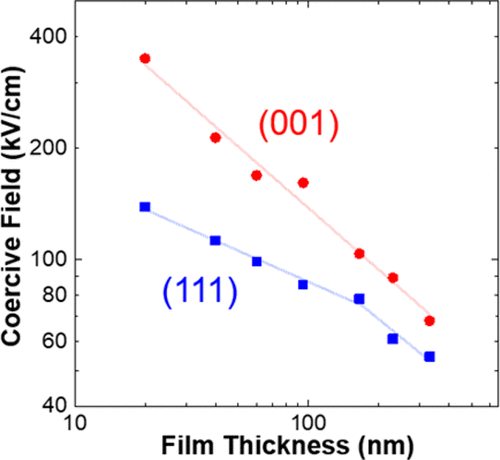Reducing Coercive-Field Scaling in Ferroelectric Thin Films via Orientation Control
Ruijuan Xu, Ran Gao, Sebastian E. Reyes-Lillo, Sahar Saremi, Yongqi Dong, Hongling Lu, Zuhuang Chen, Xiaoyan Lu, Yajun Qi, Shang-Lin Hsu, Anoop R. Damodaran, Hua Zhou, Jeffrey B. Neaton, Lane W. Martin
文献索引:10.1021/acsnano.8b01399
全文:HTML全文
摘要

The desire for low-power/voltage operation of devices is driving renewed interest in understanding scaling effects in ferroelectric thin films. As the dimensions of ferroelectrics are reduced, the properties can vary dramatically, including the robust scaling relationship between coercive field (Ec) and thickness (d), also referred to as the Janovec–Kay–Dunn (JKD) law, wherein Ec ∝ d–2/3. Here, we report that whereas (001)-oriented heterostructures follow JKD scaling across the thicknesses range of 20–330 nm, (111)-oriented heterostructures of the canonical tetragonal ferroelectric PbZr0.2Ti0.8O3 exhibit a deviation from JKD scaling wherein a smaller scaling exponent for the evolution of Ec is observed in films of thickness ≲ 165 nm. X-ray diffraction reveals that whereas (001)-oriented heterostructures remain tetragonal for all thicknesses, (111)-oriented heterostructures exhibit a transition from tetragonal-to-monoclinic symmetry in films of thickness ≲ 165 nm as a result of the compressive strain. First-principles calculations suggest that this symmetry change contributes to the deviation from the expected scaling, as the monoclinic phase has a lower energy barrier for switching. This structural evolution also gives rise to changes in the c/a lattice parameter ratio, wherein this ratio increases and decreases in (001)- and (111)-oriented heterostructures, respectively, as the films are made thinner. In (111)-oriented heterostructures, this reduced tetragonality drives a reduction of the remanent polarization and, therefore, a reduction of the domain-wall energy and overall energy barrier to switching, which further exacerbates the deviation from the expected scaling. Overall, this work demonstrates a route toward reducing coercive fields in ferroelectric thin films and provides a possible mechanism to understand the deviation from JKD scaling.
|
Prostate-Specific Membrane Antigen Targeted Gold Nanoparticl...
2018-04-16 [10.1021/acsnano.8b00940] |
|
Formation of Lead Halide Perovskite Based Plasmonic Nanolase...
2018-04-16 [10.1021/acsnano.8b01206] |
|
Doping Polymer Semiconductors by Organic Salts: Toward High-...
2018-04-16 [10.1021/acsnano.8b01460] |
|
Encapsulating Silica/Antimony into Porous Electrospun Carbon...
2018-04-13 [10.1021/acsnano.7b09092] |
|
Nanoscale Electronic Conditioning for Improvement of Nanowir...
2018-04-13 [10.1021/acsnano.8b00538] |